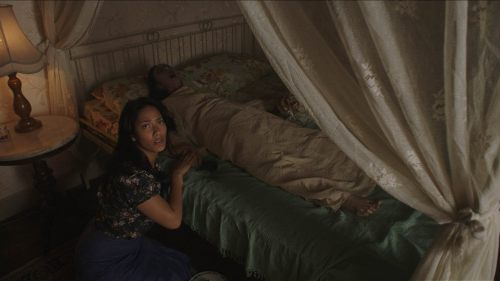SATAN’S SLAVES Review: A Gripping Indonesian Ghost Story
A self-made singer-songwriter and main provider to her husband and four children – to say that Rini’s mother is prolific would be an understatement. However, that’s not the word most would use to describe her since she got sick. For the past three years, Rini, her father, and her three brothers have been noticing a sharp decline in their mother’s health. Now, bedridden and nearly catatonic, shaking her bell at shadows, it appears that this figurehead has reached the end of her reign. Even her royalties have run dry, causing their father to run off and attempt to make some quick cash, leaving Rini alone to take care of the boys. In the aftermath of her mother’s death, this family will learn both figuratively and financially what it means to lose the head of a household, and discover how sickness can corrode the very part of us that makes us human.
Just as the lady of the house slowly disintegrates, so, too, does the house itself appear atrophied and withered away. Pale, washed out beige countertops line barren, stained walls, the burnt umber aesthetic giving the residence a feeling like it’s still recovering from a fire that never happened. The presence of death isn’t just felt through pointed plotlines and clear character motivations – you can actually see sickness taking over the lives of this unassuming Indonesian family, as the home seemingly rots from the inside out, growing visually darker as the film’s events grow more metaphorically cataclysmic.
Despite the mostly muted color scheme, after the mother dies and her ghost begins to haunt the halls of these ghastly quarters, Satan’s Slaves really takes on a giallo feel. Bembi Gusti, Tony Merle, and Aghi Narottama’s score plays like a nightmarish children’s lullaby, while Ical Tanjung’s quick zooming, rapid-fire camera close-ups wistfully capture romantic gothic imagery, like suited up, faceless gentlemen bearing black umbrellas, and beautiful women donning floral prints hunting down clues. Together, along with Allan Triyana Sebastian’s gorgeous late 1970s/early 1980s art direction, these collaborators help fuel the heightened Italian thriller feel of the film, giving this Indonesian ghost story an identity all its own.
Where Satan’s Slaves falls just shy of greatness is in its tendency to overstay its welcome. The first time we see the mother’s ghost slowly stepping into frame just as the music booms, it’s quite terrifying, especially given the excellent sound design which highlights every creaky floorboard and raspy door hinge. However, once that card’s been dealt a few times – the ghost mom comes into frame, the score mimics a cat being dropped onto a piano – the scare loses its shock value, making the already lengthy runtime feel that much longer.
Still, despite the movie being a bit too long, lead actor Tara Basro does a wonderful job of bringing a balance of familial strength and individual vulnerability to her role, helping the story feel more honest and raw. It’s hard not to fear for Rini and her brothers Toni, Bondi and Ian, as the four children scramble to scurry away from the demon wearing their mother’s face – you can really feel the family's love, which makes it all the more devastating when the spirits turn the kids against one another.
Despite its somewhat unfortunate title, Satan’s Slaves is actually a very solid illness-as-the-monster movie. Eerie and atmospheric, the film does an excellent job of frightening its audience with an admittedly terrifying spirit, while simultaneously exploring the suffering that comes with watching a loved one slowly die. The sinful desire to just make it stop – even if that means resorting to giving up on them entirely. After all, the children are afraid of their mother long before she passes away. She becomes a ghost many moons before death comes to claim her.
An Indonesian giallo ghost story, fueled by an ancient Javanese spirit, director Joko Anwar’s haunting look at the dissolution of the family unit – a popular theme for horror movies in 2018 – is well worth a watch. Although it does run on a tad too long, and leaves a few questions unanswered – where exactly did Rini’s father go to earn money? – Satan’s Slaves is a petrifying peek into the nightmarish world of watching someone you adore grow frail and otherworldly, and the trauma that can manifest into monsters as a result of such torment.

